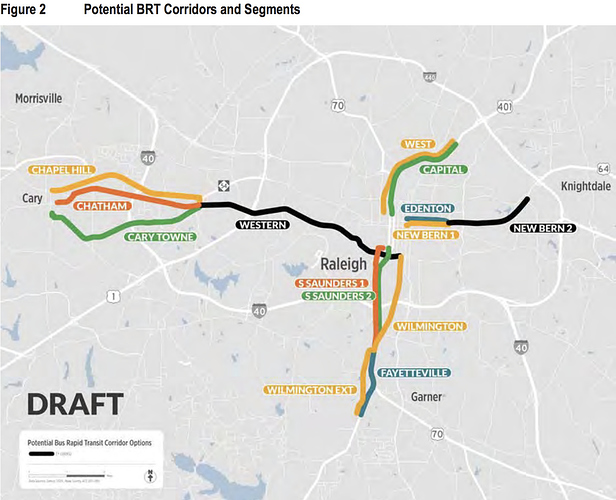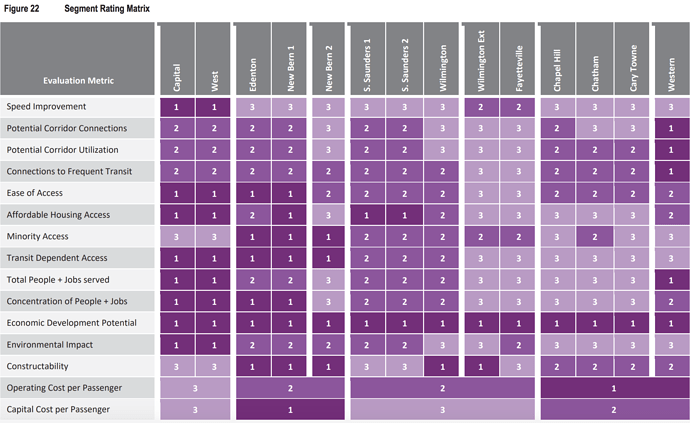Reliability is also a big issue. Sometimes the schedules on the displays at the Bus Station are different from the ones on their site and if you miss a bus you’re out of luck for the next 30 minutes to an hour on the weekends.
Even the plan produced by Jarret Walker (who is basically the strongest proponent of gridded networks in the whole industry) left the significant majority of routes, even the newly frequent routes, heading downtown and terminating there for a transfer.
This changes if you have a very high frequency, high capacity, fast rapid transit system, where it makes sense for most buses to be realigned to transfer to the rapid transit at outlying stations. If we had a frequent heavy rail line along the NCRR, for example, for somebody heading downtown from Rex Hospital, it might make more sense to ride a bus down Blue Ridge to the fairgrounds and catch a train from there, rather than to catch a direct bus, since in spite of the transfer the overall trip would be faster compared to the slow slog down Hillsborough Street in a bus. Now, it is possible to design a BRT system that can have comparable performance and fill that role. But from what I have seen, that is not what we are getting. To build a BRT that performs comparably to a rapid transit rail line costs nearly as much as building the rail line itself - you need grade separations for major roads, gates and flashers with full preemption at minor grade crossings, and big articulated buses.
Our BRT will get features like dedicated lanes in some places, but probably not everywhere, and as far as I am aware, grade separations are not on the table. The amount of money budgeted to build the BRT lines just won’t allow for it. It will speed the bus up quite a bit compared to the baseline of running in mixed traffic, and hopefully it will be much less susceptible to delays due to congestion, but there will still be places where it has to wait for stoplights. I think of it more as a way to speed up and improve the experience for the busiest, most important bus lines, rather than as a separate entity that exists on another plane entirely from the conventional bus system.
Was looking at some of the notes from the downtown BRT plan advisory committee meetings and it seems that the winner among the committee members was Scenario D, followed by Scenario A, B and then C last.
The group was encouraged to drop one scenario as a way to move towards a final recommendation and yes, C, was voted as the least favorable.
The technical committee voted this one as the least viable.
The public feedback greatly said connections to RUS/GoRaleigh are important.
Therefore C ain’t cutting it.
The fact that a scenario without connections to RUS/GoRaleigh was even considered is some amateur hour nonsense, imo.
Where can one find the notes, agendas, and minutes for these meetings? Usually I can find things like this but not having any luck today.
So Durham is going for a Subway and we are over here tinkering with bus routes
[GoTriangle submits light rail proposal to Federal Transit Administration that includes a tunnel through downtown Durham](https://gotriangle.org/news/gotriangle-submits-light-rail-proposal-federal-transit-administration-includes-tunnel-through
That will drive the cost way, way up.
It’s not exactly a subway . . . just a short tunnel under Blackwell and Mangum streets. The rest of the line will still be on the surface level.
But there will be a station in the tunnel right? I guess it may be similar to a couple stations being built on the Purple Line in Maryland. If they build it fully cut and cover and don’t have to worry about maintaining traffic flow during construction it will probably be pretty cheap as tunnels go.
Nevertheless, this feels similar in a way to 2005 as the TTA regional rail project started to fall apart. Not quite, because then they kept making cuts to compensate for cost overruns and revenue shortfalls, whereas now they keep adding scope at the last minute to bring critical stakeholders on board who I am surprised to find had not signed on ages ago. But the death by a million cuts theme is the same.
My preferred solution would be for them to raise the freight railroad over Blackwell and Mangum. This is what was studied and deemed feasible in the Traffic Separation Study from 2013. Kill two birds with one stone.
…except the two birds you’d kill with that would splatter blood more places than you’d intend.
My preferred solution would be for them to raise the freight railroad over Blackwell and Mangum. This is what was studied and deemed feasible in the Traffic Separation Study from 2013.
They were going to go with raising either of the rails, but Downtown Durham went through a really similar publicity problem with their “Great Wall of Durham”. The issue is that creating a transportation corridor that basically acts as a barrier is something Durham doesn’t want to deal with again.
Why? Because it did that about half a century ago with the Durham Freeway in the name of revitalizing blighted neighborhoods, bulldozed the historic Hayti district (aka what used to be Black Wall Street) in the process, and turned “redevelopment” into a code-word for “race-based redlining”. Sometimes, I wonder if that’s why Durham was never a big place for urban investment before the American Tobacco Campus came to be.
Plus, even today, if you go around the smaller local art shows or talk to people at hole-in-the-wall bars around there, they’ll tell you about how much harder it is to keep a community going (or it’s harder for legacy residents to regain their footing where Hayti used to be) since NC-147 dissected their neighborhood.
Either way, if you had to come up with an even less acceptable solution than what they just shot down, it’s that.
GoTriangle (then Triangle Transit) probably heard about that back in 2015. And they knew they also can’t interfere with NCRR (read: Norfolk Southern)'s right of way, too. They briefly revisited the idea earlier this year (see system page 14), but they noped out of it then, too.
So your idea sounds good on paper, yeah, but as a Chapel Hill/Durham resident, I can tell you that you DO NOT want to take this there, again.
TL/DR: the raised rail idea brings back memories of racist policies and economic suicide. GoTriangle didn’t even mention it for a reason.
This is getting off topic, but I do see what you are saying. My firm belief is that there is a way to mitigate this problem. Primarily: build it as a viaduct and use the space underneath for something that benefits the public and is more attractive. Retail under viaducts is something you will find in many places all over the world. Sometimes parks or plazas can be placed there. Even parking at least allows permeability both visually and physically.
Bringing this back to Raleigh, this is what I hope can be done when the SE High Speed Rail route is built parallel to West Street.
Edit: thinking about it, I recalled something else about the discussion several years ago. The initial plan was to raise the freight RR and the light rail together. There was some nascent community opposition but they were exploring options for mitigation. That issue did not have a chance to come to a head. In the end, the plans were scuttled by the freight railroad which refused to share a viaduct or embankment with the light rail. That is what pushed the light rail onto Pettigrew, not community opposition. (As an aside, to me this was the first sign that DOLRT was in for a rough ride.)
What I am suggesting is to keep the light rail on Pettigrew and build a viaduct for freight trains only.
Ohh, I mixed up which rails you were suggesting to raise/keep, my bad. In that case, yeah, I agree (though I wouldn’t think NCRR would be happy with that…)
Also, it looks like GoTriangle offloaded all the BRT planning work to GoRaleigh. They also came up with a draft cost-benefit analysis of each non-downtown parts of the BRT plan as a part of its Major Investment Study (MIS).
From the latest Board of Trustees papers, here. (warning: this PDF might not be here forever)
Context for 2nd image: lower number/darker color = more ideal option for each Evaluation Metric
(Specific criteria for each category listing is in full paper)
Remember:
Downtown alignments in each case will be determined by downtown studies that will be
completed following the conclusion of the MIS.
I think NCRR would be overjoyed by a plan to eliminate three or four busy and complicated grade crossings (Duke, Blackwell, Mangum, possibly Dillard) and fix three substandard grade separations (Gregson, Chapel Hill, and Roxboro) all while double tracking their route through downtown Durham.
It would be expensive. It would also be a huge aesthetic improvement over existing conditions, if done right.
Relocate the GoDurham bus bays to under the tracks. Sell the existing transfer center for redevelopment (keeping the Freelon designed headhouse as the waiting room and intercity bus station). To expect $5 million per acre is not unreasonable given this location right next to ATHD and the light rail. This is about 2.5 acres, so $12.5 million. That should cover the cost of relocating the bus bays with extra money left over. You could also punch through a new pedestrian passageway, maybe two, from Pettigrew to Ramseur, somewhere between Chapel Hill and Blackwell. Put some retail space under the tracks elsewhere. Go for something that looks like this:
As an aside this is what I want to see when they build the elevated High Speed Rail line through Glenwood South along West Street.
I absolutely love this picture/shot, thank you!
Also, wouldn’t it be nice to have something similar if or when they have one at the “State Government” stop?
Somehow I didn’t realize the BRT will go past the 70 interchange. I thought it ended at Tryon Road. I know that’s not DT, but there’s a lot of potential redevelopment down there.
Really I want to see them build the new HSR route as a four track corridor and close the existing CSX route by the State Government complex and between the Cotton Mill and Logan’s. IMO there is no reason to have two RR corridors heading north from downtown when they are together where they cross Jones Street and just cross back over each other near where Atlantic meets Capital. The vacated land could be turned into a busway or a high line style greenway or a new street or new development or any number of cool things.
The city has decided on New Bern Ave. becoming the first BRT location.
They are presenting an application for federal grant money this year, and hoping for first service in 2023.
https://screenshots.firefox.com/xlGe5JsVlelUjKTK/twitter.com
https://screenshots.firefox.com/1NXGCJHqyG29aYaQ/twitter.com
Glad it’s moving forward but 2023 seems like a long time for just the first route. Hoping the rest of the planned BRT routes follow quickly.


